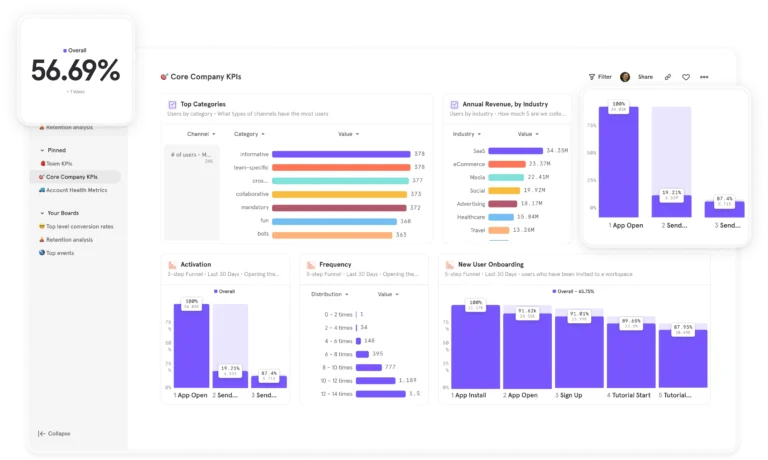What is customer analytics?
Customer analytics is the process companies use to capture and analyze customer data to make better decisions. Companies usually use specialized software to gather and parse the user behavior data that drives customer analytics processes. The insights garnered power businesses’ sales, marketing, and product development efforts, and studies show that companies that use customer analytics are more profitable.
The key to building a valuable product is understanding what your customers want. There are lots of ways to do that: customer interviews, surveys, and market research, to name just a few. But these methods only offer limited insights into how your customers behave, because they’re all based on what customers say they do, not what they actually do.
If you want to understand your customers and how they really interact with your product at scale, you need customer analytics.
We’ve put together a quick rundown of what customer analytics is, how it works, and some examples of how to use it.
What is customer analytics?
Customer analytics is the process companies use to capture and analyze customer data to make better decisions. Customer analytics often comes as software that furnishes companies with insights into their users’ behaviors. These insights power businesses’ sales, marketing, and product development efforts.
Customer analytics can help companies understand—and ultimately influence—customer behaviors. With customer analytics, you can answer questions like which channels drive the most users, which features customers find valuable (and which ones they don’t), and what actions free users take before becoming paying customers.
All of that information is valuable for making decisions about the product roadmap and business strategy.
Why do companies use customer analytics?
Customer analytics helps businesses break big problems into manageable answers. When companies need to look at how their customers behave, either as individuals or overall, customer analytics decodes their actions so that they’re easier to understand.
This helps companies make better decisions on pricing, promotion, and management. According to McKinsey, “Companies that use customer analytics comprehensively report outstripping their competition in terms of profit almost twice as often as companies that do not.”
A good customer analytics platform can help your team increase:
- Mobile adoption
- Customer retention
- User engagement
- In-app purchases
Analytics platforms help companies keep pace with an increasingly sophisticated consumer base. According to an IBM study, 85 percent of customers now expect a seamless experience, desire faster responses, count on omnichannel support, and have less attention to spare. Analytics help companies measure and improve their products to cater to modern customers.

How does customer analytics work?
Customer analytics gives companies full visibility into how customers use their products. Analytics is particularly useful for digital product companies because they can collect step-by-step data on how customers, users, or subscribers flow through their sites or apps.
At a macro level, this exposes major trends such as how users discover their product, which features they like best, where they find value, and what causes them to leave. At a micro level, customer analytics allows companies to understand who their users are as individuals. They can segment users by demographics, interests, and behaviors and view their unique journeys.
This knowledge helps businesses better cater to each customer persona. Elavon, for example, is a mobile payment platform that found its users were complaining they couldn’t download the app. By using Mixpanel’s customer analytics software, they were able to instantly identify all users trying to download the app on incompatible OS systems, reach out, and suggest a fix.
Customer analytics in practice: How customer analytics impacts different business functions
Different teams will use customer analytics for different purposes. As long as they’re all working from the same data toward shared company goals, customer analytics will help break down silos and foster cross-team collaboration.
Here are a few examples of how customer analytics play a role in different business functions:
Product
Product teams use customer analytics to analyze feature adoption and retention trends. They can also measure usage and feature success more broadly, or dive deeper into customer journeys to understand how customers interact with their product.
Customer analytics for Product: Yelp
Yelp was stuck doing analysis manually, which slowed down its decision-making process. They added customer analytics to their internal logging platform to get better insights faster, which allowed them to understand their customers more quickly and reduce the time between ideation and launch for critical features.
Read the full case study.
Marketing
Marketing teams can use customer analytics to measure campaign effectiveness, segment users to understand their audience on a more granular level, identify their most engaged users, and use those insights to create lookalike audiences for future campaigns.
Customer analytics for Marketing: Shift
Shift wanted to increase the number of paid plan users. To do that, they needed to identify a North Star metric that would help drive users to purchase. They used Mixpanel to run a self-service correlation analysis and quickly found the right metric (setting up multiple email accounts).
They used this insight to make it easier for users to add two or more accounts. But they didn’t stop there. Once they had identified this audience, marketing, and product used the data to create lookalike audiences for their Facebook and Google Ads campaigns, narrowing their targeting to potential customers most likely to be interested.
Read the full case study.
Customer Success
Customer analytics can help CS teams understand their customers before they talk to them, then track the effectiveness of the conversations they have. Customer success teams can also use analytics to tie their actions to customer behaviors, using that data to set KPIs for the team.
Customer analytics for CS: Pugpig
Before using Mixpanel, the team at mobile publishing platform Pugpig was using Google Analytics, which didn’t give them insights into what users actually did once they had arrived on their platform. They were limited to looking at their data on a publication-by-publication basis. Thanks to Mixpanel,the team was ablel to develop a set of KPIs to measure customer success. They use customer analytics insights to drive decision-making across numerous teams, from product to customer success to support.
Sales
Sales teams can use customer analytics to score leads, prospects, and users. They can use that information to identify high-value customer segments and focus their efforts on those prospects.
Want more examples of customer analytics in practice? Here are eight analytics use cases from our best customer stories.
What questions can customer analytics answer?
Customer analytics platforms can answer questions on anything that can be measured or tracked. That said, the answers they provide are only as good as the questions asked of them. Open-ended, subjective, or relative questions like, “Is our product the best?” are difficult to clearly answer. Good questions are concrete, easily proved or disproved, and tie back to core business objectives like acquisition, revenue, retention, and engagement. Examples of common customer analytics questions:
Acquisition
- Which channels drive the most new customers?
- What is the most common customer journey from awareness to advocacy?
Revenue
- What are our most profitable revenue channels?
- Which users are the most profitable?
Retention
- Where do we lose customers and why?
- What behaviors are correlated with high retention rates?
Engagement
- What features resonate with which customers?
- What is the optimal experience for users?
Challenges of customer analytics
Customer analytics is important, but that doesn’t mean it’s easy to implement. Companies working with customer analytics for the first time can face data integration and accessibility issues, especially if their data is stored in different tools that aren’t well integrated. Businesses need a central repository of data, like a data warehouse, and a way for employees to self-serve analysis of that data.
Another challenge when handling customer data is compliance: Different countries have different regulations around data storage and security, and laws like the GDPR ensure customers have certain rights when it comes to their data. Customer analytics tools with data governance features can help companies remain compliant while gathering insights.
How to implement customer analytics
To receive accurate answers from their customer analytics platforms, businesses capture and analyze their data. For this, proper implementation is key.
To implement customer analytics and derive useful insights, companies must do two things:
- Capture, store, and organize their data.
- Analyze and make decisions with that data.
To capture and make use of data, companies must collect lots of it. They may run surveys, conduct user research, purchase third-party data, and, if they offer a technology solution, passively collect usage data through their site or app.
In the case of websites, most customer analytics platforms passively collect all visitor data. With apps, companies may need to define activities or “events” where data is collected, such as login, logout, and user actions.
For storing data, it’s useful to have a central repository that unites all of your data sources into one single view of your customer. This is a key feature of most customer analytics platforms.

Companies that do not properly maintain their data will have trouble getting straight answers from their customer analytics. If data is stale, unstructured, or incomplete, it may lead to misleading results. This often happens when there has been a lack of process, multiple owners over the years, or when companies have custom-built their own customer analytics platforms.
To analyze and interpret results, it can help to have a dedicated product manager, UX/UI designer, or data scientist. They’ll be able to frame customer analytics inquiries in terms of core business objectives and steer the company toward better results.
Companies that invest in customer analytics have an advantage over the competition because they can more easily understand and cater to their customers’ needs.
How Mixpanel simplifies customer analytics
Mixpanel delivers real-time insights that help you identify and understand customer trends. You can use cohort analysis to break customers into groups and understand their behavior over time.
Custom dashboards keep different teams aligned and working with the same customer data toward shared goals. With instant, self-serve access to customer analytics, your entire company can gather actionable insights to drive product improvements and marketing campaigns.


